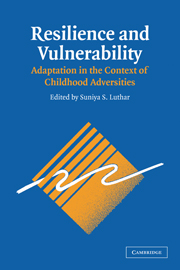Book contents
- Frontmatter
- Contents
- List of Contributors
- Foreword by Dante Cicchetti
- Preface
- 1 A Resilience Framework for Research, Policy, and Practice
- PART I FAMILIAL ADVERSITIES: PARENTAL PSYCHOPATHOLOGY AND FAMILY PROCESSES
- PART II EXOSYSTEMIC AND SOCIODEMOGRAPHIC RISKS
- 10 Rethinking Resilience: A Developmental Process Perspective
- 11 Poverty and Early Childhood Adjustment
- 12 Emerging Perspectives on Context Specificity of Children's Adaptation and Resilience: Evidence from a Decade of Research with Urban Children in Adversity
- 13 Holistic Contextual Perspectives on Risk, Protection, and Competence among Low-Income Urban Adolescents
- 14 Overcoming the Odds? Adolescent Development in the Context of Urban Poverty
- 15 Adaptation among Youth Facing Multiple Risks: Prospective Research Findings
- 16 Positive Adaptation among Youth Exposed to Community Violence
- 17 Perceived Discrimination and Resilience
- 18 Promoting Resilience through Early Childhood Intervention
- PART III COMMENTARIES
- Index
- References
13 - Holistic Contextual Perspectives on Risk, Protection, and Competence among Low-Income Urban Adolescents
Published online by Cambridge University Press: 05 June 2012
- Frontmatter
- Contents
- List of Contributors
- Foreword by Dante Cicchetti
- Preface
- 1 A Resilience Framework for Research, Policy, and Practice
- PART I FAMILIAL ADVERSITIES: PARENTAL PSYCHOPATHOLOGY AND FAMILY PROCESSES
- PART II EXOSYSTEMIC AND SOCIODEMOGRAPHIC RISKS
- 10 Rethinking Resilience: A Developmental Process Perspective
- 11 Poverty and Early Childhood Adjustment
- 12 Emerging Perspectives on Context Specificity of Children's Adaptation and Resilience: Evidence from a Decade of Research with Urban Children in Adversity
- 13 Holistic Contextual Perspectives on Risk, Protection, and Competence among Low-Income Urban Adolescents
- 14 Overcoming the Odds? Adolescent Development in the Context of Urban Poverty
- 15 Adaptation among Youth Facing Multiple Risks: Prospective Research Findings
- 16 Positive Adaptation among Youth Exposed to Community Violence
- 17 Perceived Discrimination and Resilience
- 18 Promoting Resilience through Early Childhood Intervention
- PART III COMMENTARIES
- Index
- References
Summary
What are the characteristic ways in which risk, vulnerability, protection, and competence have been studied? What are the implicit assumptions underlying this body of research and scholarship? This chapter addresses these questions in the domain of adolescent development, with an emphasis on how a set of alternative assumptions and related research and data analytic strategies can both enrich our understanding of youth well-being and increase our ability to promote positive developmental outcomes.
RISK, PROTECTION, AND COMPETENCE
We define the central phenomena of interest: risk, vulnerability, protection, and competence. Either an individual or a population can be at increased risk for some form of negative developmental outcome, be it delinquency, drug use, depression, schizophrenia, school dropout, or unemployment. Multiple risk or vulnerability factors increase the likelihood that an individual or a population will manifest negative developmental outcomes. Many studies indicate that it is not any single risk factor that is problematic, but the accumulation of multiple risks (e.g., Sameroff & Seifer, 1990). Protective factors are defined as experiences that ameliorate the negative impact of risks. Some investigators have operationalized protective and vulnerability factors in conjunction with each other as part of a multiple risk index (Sameroff & Seifer, 1990), whereas other scholars have argued that protective processes are set in motion only in the presence of adverse risk factors (Rutter, 1990).
- Type
- Chapter
- Information
- Resilience and VulnerabilityAdaptation in the Context of Childhood Adversities, pp. 318 - 342Publisher: Cambridge University PressPrint publication year: 2003
References
- 27
- Cited by



